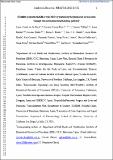Por favor, use este identificador para citar o enlazar a este item:
http://hdl.handle.net/10261/260589COMPARTIR / EXPORTAR:
 SHARE SHARE
 CORE
BASE CORE
BASE
|
|
| Visualizar otros formatos: MARC | Dublin Core | RDF | ORE | MODS | METS | DIDL | DATACITE | |

| Título: | STARD1 promotes NASH-driven HCC by sustaining the generation of bile acids through the alternative mitochondrial pathway |
Autor: | Conde de la Rosa, Laura CSIC ORCID ; García-Ruiz, Carmen CSIC ORCID ; Vallejo, Carmen CSIC; Baulies, Anna CSIC ORCID; Nuñez, Susana CSIC; Monte, Maria J.; Marín, José J. G.; Baila-Rueda, Lucía; Cenarro, Ana; Civeira, Fernando; Fuster, Josep; García-Valdecasas, Juan Carlos; Ferrer, Joana; Karin, Michael; Ribas, Vicent CSIC ORCID; Fernández-Checa, José C. CSIC ORCID | Palabras clave: | Cholesterol Mitochondria Bile acids Hepatocellular carcinoma Oxysterols STARD1 |
Fecha de publicación: | jun-2021 | Editor: | Elsevier BV | Citación: | Journal of Hepatology 74: 1429-1441 (2021) | Resumen: | Background & Aims Besides their physiological role in bile formation and fat digestion, bile acids (BAs) synthesised from cholesterol in hepatocytes act as signalling molecules that modulate hepatocellular carcinoma (HCC). Trafficking of cholesterol to mitochondria through steroidogenic acute regulatory protein 1 (STARD1) is the rate-limiting step in the alternative pathway of BA generation, the physiological relevance of which is not well understood. Moreover, the specific contribution of the STARD1-dependent BA synthesis pathway to HCC has not been previously explored. Methods STARD1 expression was analyzed in a cohort of human non-alcoholic steatohepatitis (NASH)-derived HCC specimens. Experimental NASH-driven HCC models included MUP-uPA mice fed a high-fat high-cholesterol (HFHC) diet and diethylnitrosamine (DEN) treatment in wild-type (WT) mice fed a HFHC diet. Molecular species of BAs and oxysterols were analyzed by mass spectrometry. Effects of NASH-derived BA profiles were investigated in tumour-initiated stem-like cells (TICs) and primary mouse hepatocytes (PMHs). Results Patients with NASH-associated HCC exhibited increased hepatic expression of STARD1 and an enhanced BA pool. Using NASH-driven HCC models, STARD1 overexpression in WT mice increased liver tumour multiplicity, whereas hepatocyte-specific STARD1 deletion (Stard1ΔHep) in WT or MUP-uPA mice reduced tumour burden. These findings mirrored the levels of unconjugated primary BAs, β-muricholic acid and cholic acid, and their tauroconjugates in STARD1-overexpressing and Stard1ΔHep mice. Incubation of TICs or PMHs with a mix of BAs mimicking this profile stimulated expression of genes involved in pluripotency, stemness and inflammation. Conclusions The study reveals a previously unrecognised role of STARD1 in HCC pathogenesis, wherein it promotes the synthesis of primary BAs through the mitochondrial pathway, the products of which act in TICs to stimulate self-renewal, stemness and inflammation. Lay summary Effective therapy for hepatocellular carcinoma (HCC) is limited because of our incomplete understanding of its pathogenesis. The contribution of the alternative pathway of bile acid (BA) synthesis to HCC development is unknown. We uncover a key role for steroidogenic acute regulatory protein 1 (STARD1) in non-alcoholic steatohepatitis-driven HCC, wherein it stimulates the generation of BAs in the mitochondrial acidic pathway, the products of which stimulate hepatocyte pluripotency and self-renewal, as well as inflammation. | Versión del editor: | http://dx.doi.org/10.1016/j.jhep.2021.01.028 | URI: | http://hdl.handle.net/10261/260589 | DOI: | 10.1016/j.jhep.2021.01.028 | Identificadores: | doi: 10.1016/j.jhep.2021.01.028 issn: 0168-8278 |
| Aparece en las colecciones: | (IIBB) Artículos |
Ficheros en este ítem:
| Fichero | Descripción | Tamaño | Formato | |
|---|---|---|---|---|
| Checa - Journal of Hepatology 74 1429-1441 (2021) - Pre-proof_compressed.pdf | 305,62 kB | Adobe PDF |  Visualizar/Abrir | |
| Checa - Journal of Hepatology 74 1429-1441 (2021) - STARD1 promotes NASH-driven HCC_compressed (1).pdf | 1,73 MB | Adobe PDF |  Visualizar/Abrir |
CORE Recommender
Page view(s)
96
checked on 27-abr-2024
Download(s)
815
checked on 27-abr-2024
Google ScholarTM
Check
Altmetric
Altmetric
NOTA: Los ítems de Digital.CSIC están protegidos por copyright, con todos los derechos reservados, a menos que se indique lo contrario.
